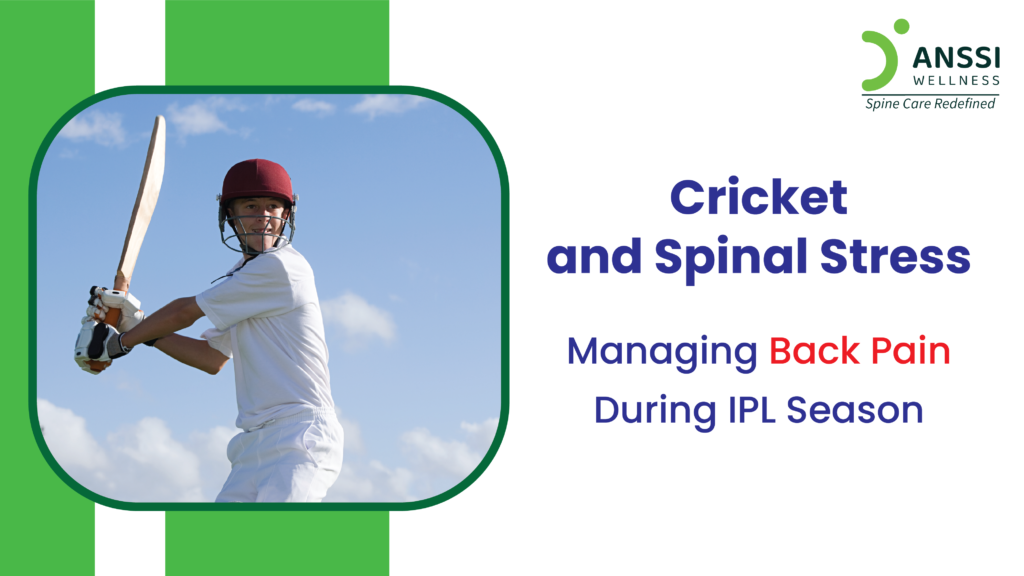Playing through a mega sports event like the Indian Premier League (IPL) requires immense physical endurance, and back pain is a common challenge for many cricketers.
Such Premier league competitions are the most intense and physically demanding tournaments in the world. With back-to-back matches, gruelling training sessions, and high-pressure performances, players, especially fast bowlers and all-rounders, put immense strain on their bodies, particularly their spines.
Chronic back pain is a common issue among cricketers, and managing it effectively is crucial for sustaining performance throughout the season. So, let’s explore the physical toll of cricket, common back injuries among players, and the non-surgical strategies they use to recover and stay at the top of their game.
The Physical Demands of Cricket on the Spine
Cricket may not involve continuous movement like football or basketball, but it demands bursts of explosive action, sudden changes in direction, and repetitive motions that stress the spine. The back, particularly the lower lumbar region, bears the brunt of these movements.
Fast Bowlers: The Most Vulnerable to Back Injuries
Fast bowlers are at the highest risk of back injuries due to the repetitive and high-impact nature of their action.
Each delivery puts immense pressure on their spine, as they:
- Twist their torso during the run-up.
- Hyperextend their lower back at the point of release.
- Absorb the shock of landing on one leg repeatedly.
Over time, these factors contribute to stress fractures, disc herniation, and muscle strains.
All-Rounders: Balancing Multiple Roles with Added Strain
All-rounders face unique challenges as they switch between explosive batting, powerful bowling, and dynamic fielding. This constant shift in physical demands makes them more prone to chronic pain and fatigue-related spinal issues.
Batsmen and Fielders: Not Immune to Back Stress
While batsmen and fielders experience lower impact compared to bowlers, they are not exempt from spinal stress. Long hours at the crease, sudden sprints, diving stops, and improper posture while batting can lead to muscle imbalances, stiffness, and pain.
Common Back Injuries in Cricketers
- Disc Herniation (Slipped Disc): Repeated twisting, bending, and impact can cause a spinal disc to bulge or rupture, pressing against nerves and causing sharp pain, numbness, and weakness.
- Stress Fractures in the Lower Spine: Fast bowlers often develop small fractures in their lumbar vertebrae due to repetitive impact and hyperextension during bowling. This injury can cause severe discomfort and, if ignored, lead to long-term issues.
- Muscle Strains and Ligament Sprains: Overuse, sudden jerks, or improper warm-ups can lead to muscle strains or ligament sprains in the lower back, resulting in stiffness and limited movement.
- Facet Joint Injuries: These occur when the small joints in the spine are overstressed, leading to pain and reduced flexibility. Prolonged standing, improper posture, and sudden movements contribute to this condition.
Non-Surgical Treatments and Recovery Strategies Used by Professional Players
To avoid long recovery periods and maintain peak performance, players rely on non-surgical treatment options to manage back pain and prevent further injury.
Non-Surgical Spinal Decompression Treatment (SDDT)
One of the most effective non-invasive treatments for back pain is Non-Surgical Spinal Decompression Treatment (SDDT). This technique gently stretches the spine, creating negative pressure in the discs, allowing herniated material to retract and relieve nerve pressure.
The benefits of SDDT include:
- Pain relief without surgery or injections.
- Increased nutrient flow to the spine, aiding in healing.
- Improved flexibility and reduced stiffness.
Many professional athletes undergo regular spinal decompression sessions to enhance recovery and prolong their careers.
Physiotherapy and Rehabilitation
A structured rehabilitation program plays a key role in back pain management.
Physiotherapists guide players through:
- Strengthening exercises for core and back muscles.
- Flexibility routines to maintain spinal mobility.
- Postural corrections to reduce stress on the spine.
The Role of Sports Massage and Myofascial Release
Deep tissue massage and myofascial release therapy help in:
- Reducing muscle tension and spasms.
- Improving blood circulation to promote healing.
- Preventing scar tissue formation in injured areas.
Hydrotherapy and Cryotherapy
Professional players often use hydrotherapy (water-based exercises) and cryotherapy (cold therapy) to accelerate recovery.
These techniques:
- Reduce inflammation and swelling.
- Provide pain relief through controlled movement in water.
- Enhance muscle relaxation and recovery.
Core Stability and Strength Training
Building a strong core is crucial for spinal support. Cricketers follow targeted training programs that focus on:
- Strengthening abdominal, oblique, and lower back muscles.
- Improving balance and posture through functional exercises.
- Reducing strain on the spine during intense physical activity.
Proper Rest and Recovery Strategies
With a high-intensity cricket schedule, rest and sleep become critical for healing.
Players follow recovery strategies to ensure:
- Sleep Hygiene: Using supportive mattresses and pillows for spinal alignment.
- Active Recovery: Engaging in light movement rather than complete rest.
- Stress Management: Practising mindfulness and breathing exercises to reduce tension.
Ergonomic Adjustments and Posture Correction
To prevent worsening of back pain, players make necessary changes in their daily habits, including:
- Using lumbar-supportive chairs while sitting.
- Maintaining correct posture during batting and bowling.
- Avoiding prolonged static positions, whether standing or sitting.
Seeking an effective treatment with proper lifestyle adjustments can make all the difference in staying active and pain-free.
About ANSSI:
ANSSI Wellness focuses on improving the quality of life for patients suffering from spinal issues, aiming to provide relief where other conventional treatments have failed. Through advanced non-surgical spinal decompression treatment, ANSSI is committed to helping patients avoid surgery and recover in a safe, effective, and compassionate environment.
Connect with ANSSI Wellness on LinkedIn, Instagram, and Facebook for expert guidance.



